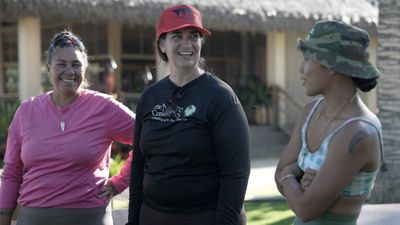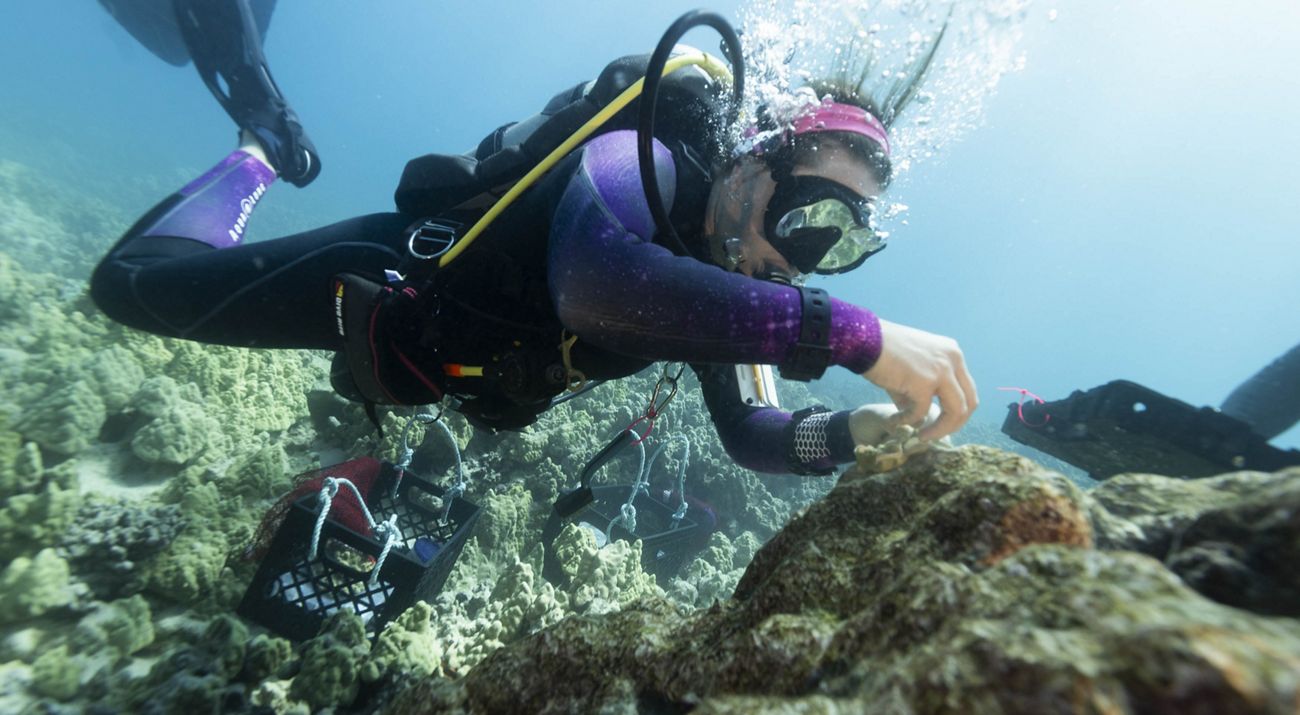Partnership Celebrates Launch of Kanu Ko‘a, First Community-Led Coral Reef Restoration Project on the Island of Hawaiʻi
Media Contacts
-
Evelyn Wight
The Nature Conservancy
Phone: 808-587-6277
Email: ewight@tnc.org
On October 30, 2023, The Nature Conservancy, Hawai‘i and Palmyra (TNC) and the Kaʻūpūlehu Marine Life Advisory Committee (KMLAC) launched Kanu Ko‘a (“Planting Corals”), the first community-led coral reef restoration project on the Island of Hawaiʻi. Kanu Ko‘a is a project that integrates Hawaiian culture, local community and the science of coral restoration to accelerate coral reef growth and recovery. The ceremony was rooted in Hawaiian cultural practice and protocol, emphasizing ‘ohana (family) relationships with ko‘a (corals).
“In Kumulipo, our creation chant, ko‘a is the first life that came from the dark, from pō. Everything else was born after that, and we are all related,” says Ku‘ulei Keakealani, a KMLAC member. “Whether we know it or not, we are dependent on ko‘a: like trees, ko‘a provides literally the breath of life. This project is a model of our interdependency with ko‘a: I ola 'oe, i ola mākou nei—when you live, we live. It is a manifestation of our kuleana, of our reciprocal relationship with that which gives us life,” she says.
At the event, project partners planted ko‘a in Kahuwai Bay, within the ahupuaʻa of Kaʻūpūlehu. TNC divers and Native Hawaiian lineal descendants of Kaʻūpūlehu collected pieces of ko‘a within the bay that had broken off during recent high swells and would have otherwise died. Ko‘a pieces were brought to shore on waʻa Kinikini, a double-hulled canoe. Together, the team used specialized saws to cut the collected pieces into 1-inch fragments. Scuba divers transported the pieces back into the bay and affixed them to the reef with epoxy, while snorkelers watched from above. Ko‘a pieces were planted in clusters, enabling them to grow together into a colony more quickly. All work with ko‘a is being conducted under a Special Activities Permit with the State Division of Aquatic Resources.

“We are honored to support and work with the KMLAC and other communities who embrace their ancestral relationships to these places and perpetuate their cultural heritage along this coastline,” says Rebecca Most, TNC marine program director on the Island of Hawaiʻi. “Together, we are building coral reefs’ ability to withstand the growing effects of the climate crisis.”
Coral reef health across the islands continues to decline, but reef restoration can build their resilience and help them recover. Scientists estimate that live coral cover on some Hawai‘i reefs has declined by 60% over the past 40 years, due in part to overfishing and pollutants washing in from land. The climate crisis exacerbates this decline, with three coral bleaching events in the last decade resulting in a 30% loss of live coral cover statewide. Effective local stewardship has helped some areas build resilience: human impacts have been reduced, and fish populations, including grazing fish, have increased. But warming oceans, more frequent severe storms and continuing land-based impacts will lead to future losses. Combined with community-led management, restoration can help mitigate these losses and catalyze recovery.
Kaʻūpūlehu was prioritized for restoration through a statewide planning process because it is a healthy, well-managed area where restoration is likely to succeed. Kahuwai Bay has few land-based pollution sources and is in a sheltered location that is less likely to experience severe storm damage. The bay is also within the Kaʻūpūlehu Marine Reserve, a 10-year rest area established in 2016 along 3.6 miles of coastline to give fish populations an opportunity to replenish. TNC surveys within the rest area showed a 612% increase in prime spawners (fish that lay the most eggs) in just four years.
Quote: Joe Pollock, Ph.D.
By anchoring this project in science and culture while prioritizing learning and knowledge sharing, we can enhance local reef benefits while disseminating the insights needed to successfully scale up reef restoration throughout Hawai‘i and beyond.
“Impacts on coral over the past decade have been devastating,” says TNC Trustee and KMLAC member Vern Yamanaka. “As stewards of Kaʻūpūlehu, it is our kuleana and obligation to do what we can to protect coral, the basis of life in our nearshore waters. We need healthy coral reefs to maintain the marine life we are working to preserve, protect and sustainably manage, and this project will help us do that.”
This event is the first step in determining the best restoration method for ko‘a species that surround the Island of Hawaiʻi. Next steps include planting whole pieces of broken corals and installing an in-water nursery table to grow corals from fragments, which will then be out planted. During the next year, the KMLAC-TNC team will monitor the growth rates and health of the planted ko‘a to evaluate which method of planting—whole pieces, fragments or nursery-grown fragments—helps ko‘a grow best.
“Restoration is an important tool in the fight against reef decline, but its adoption in Hawai‘i and the Pacific is relatively novel,” says Joe Pollock, Ph.D., TNC senior coral reef resilience scientist. “By anchoring this project in science and culture while prioritizing learning and knowledge sharing, we can enhance local reef benefits while disseminating the insights needed to successfully scale up reef restoration throughout Hawai'i and beyond.”
Photos and b-roll available here; captions and photo credits are embedded in file names.
###
The Kaʻūpūlehu Marine Life Advisory Committee (KMLAC) is a collaborative effort between the Native Hawaiian lineal descendants of Ka’ūpūlehu, representatives from Kamehameha Schools, the Office of Hawaiian Affairs, lessees within the ahupuaʻa, resource managers, local non-governmental organizations and state agency staff. The KMLAC is devoted to perpetuating the legacy of our forebearers to protect, tend and restore the biocultural resources of Ka’ūpūlehu. Visit us on Facebook and Instagram.
The Nature Conservancy is a global non-profit organization dedicated to conserving the lands and waters on which all life depends. Informed by science and guided by traditional values and practices, we apply innovative, nature-based solutions to our world’s toughest challenges so that nature and people can thrive. TNC has forged partnerships to manage 14 preserves and other sites in Hawai‘i and Palmyra Atoll, working with government, private parties and communities to protect Hawai‘i’s and Palmyra’s forests and coral reefs for their ecological value and for the many benefits they provide to people. Visit nature.org/HawaiiPalmyra.
The Nature Conservancy is a global conservation organization dedicated to conserving the lands and waters on which all life depends. Guided by science, we create innovative, on-the-ground solutions to our world’s toughest challenges so that nature and people can thrive together. We are tackling climate change, conserving lands, waters and oceans at an unprecedented scale, providing food and water sustainably and helping make cities more resilient. The Nature Conservancy is working to make a lasting difference around the world in 81 countries and territories (40 by direct conservation impact and 41 through partners) through a collaborative approach that engages local communities, governments, the private sector, and other partners. To learn more, visit nature.org or follow @nature_press on X.
